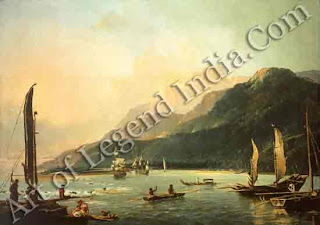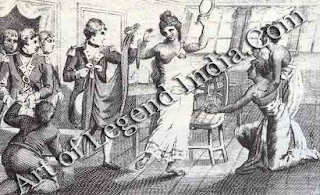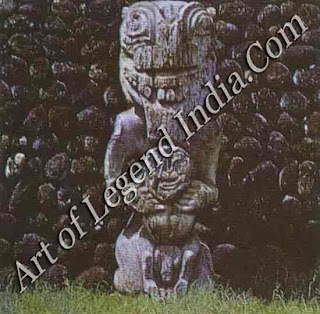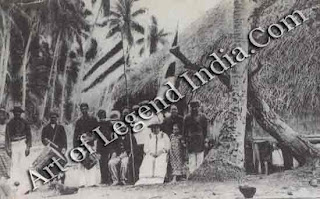French Great Artist Paul Gauguin -The Lure of Tahiti
Posted by
Art Of Legend India [dot] Com
On
4:57 AM
The
jewel of the vast Pacific Ocean, Tahiti was famed as a paradise
on
earth long before Gauguin visited its shores. European sailors
had
savoured the island's pleasures since the days of Captain Cook.
In
1890, Gauguin wrote to a friend 'I am leaving for Tahiti, where I shall hope to
end my days.' His decision was influenced partly by the fact that Tahiti was as
far away from Paris as it was possible to get,, but also by the stream of
enthusiastic reports reaching Europe from travellers who had visited the
hauntingly beautiful island.
The
unspoiled paradise of Gauguin's dreams, however, had vanished long before he
reached the capital Papeete in 1891. There were church bells and gendarmes
awaiting him as well as lovely garlanded maidens, stolid French housewives
preparing old-fashioned country meals as well as carefree islanders living free
off taro, yam and breadfruit. The 'mysterious beings' he had imagined before
his arrival managed to consume 45,000 gallons of island rum and 65,000 gallons
of imported claret each year.
But the
place itself was too lovely and the people too resilient for either to be
spoiled completely. Communications were so bad that Europeanized Papeete could
not make much of an impression on the rest of the island. Even today the only
real road follows the coast, and in the 1890s, the interior was largely
trackless. In rural districts, people lived much as they always had, by fishing
or small-scale farming.
Tahiti
had a mesmerizing effect on Gauguin, as it had on other European visitors since
its discovery by Britain's Captain Samuel Wallis in 1767. An extinct volcano
lost in the immensity of the South Pacific, its lush, green slopes rise to a
7,349-foot peak, high above a shoreline ringed by coral reefs that enclose
lagoons swarming with fish. But it was the island's inhabitants who made the
greatest impression on the early explorers. They were handsome and easy-going
people, Polynesians whose ancestors had settled around 4,000 years ago. In
Tahiti they had evolved a lifestyle that Westerners, accustomed to the drudgery
g. of their own societies, saw as a kind of paradise. The climate, though a
little damp, was balmy and reasonably cool by tropical standards. Fish and
shellfish, breadfruit and bananas seemed to be had for the asking, without
labour. There was little need for clothing. And as Wallis and his crew
discovered to the captain's horror and the men's delight the languid young
women of the island were only too willing to exchange their favors’ for some
trifling gift. Iron nails were the favoured currency: by the time Wallis sailed
for home after a F month's sojourn, the fixed bayonets of his Royal Marines
were barely enough to stop his men prising out every iron fastening in the ship.
While
Wallis, a tough but unimaginative officer, was preparing his report for the
Admiralty, an explorer with a more philosophical turn of mind 5 was making his
landfall on Tahiti. Louis Antoine de Bougainville was not only a soldier and a
navigator. He was also steeped in the new ideas sweeping 18th-century Europe.
And in Tahiti he found a reality to match philosopher Jean-Jacques Rousseau's
ideal of the noble savage of man at peace with nature.
Bougainville
and his crew were welcomed as Wallis had been. 'They pressed us to choose a
woman and to come on shore with her,' he wrote, 'and their gestures, which were
unmistakably clear, denoted in what manner we should form an acquaintance with
her.' His naturalist, Philibert Commerson, enthused about 'natural man, who is
born essentially good, free of every prejudice, and who follows, without
defiance and without remorse, the gentle impulses of instinct not yet corrupted
by reason.'
Commerson's
was a notion that endured until Gauguin's time and after. But although it
contained a germ of truth, it was largely illusion born out of wishful
thinking. For life on Tahiti was no idyll. The islanders did not use the
leisure time granted by their comfortable environment to live the kind of
rapturous, untrammelled existence dreamed of by European philosophers. Instead,
with or without assistance from 'the gentle impulses of instinct', they had
created a fierce warrior society that indulged in slavery and human sacrifice.
Nor did
the blithe promiscuity of many young Tahitian women mean that they were
devotees of free love. In fact, the Tahitians had a complex set of rules for
sexual behavior inside and outside marriage, which even today anthropologists
have not fully elucidated. a European who made an enthusiastic grab for the
wrong woman could and often did pay for it with his life.
Nevertheless,
the island never lost its seductive fascination. Captain James Cook, who
visited it in 1769, was reduced to holding Tahitian chiefs hostage to obtain
the return of deserters from his ship and Cook was a well-loved leader. In
1789, the contrast between Tahitian life and Royal Naval discipline was enough
to provoke the celebrated mutiny on HMS Bounty. Regardless of its flaws,
paradise Tahiti-style was better than life on ship.
But the
coming of the Europeans was itself enough to put an end to the old way of life.
The newcomers brought syphilis, a poor return for the island women's
affections. They brought measles and smallpox and a host of other diseases to
which the Polynesians had little or no resistance. They brought rum. And
unscrupulous and well-armed Europeans took sides for their own advantage in the
island's internal quarrels, which were bloody enough already without their
help.
The
results were quite devastating. According to some estimates, Tahiti's 402
square miles supported as many as 150,000 people before the Europeans came. By
the end of the century the population had crashed to 15,000; by 1830 it had
fallen to 8,000.
Missionaries
did their own kind of damage. Their first settlement was established in 1797,
and although they did their best to protect their flocks from the ravages of
drink and disease, they eventually succeeded in undermining the local
traditions that any society needs in order to keep its self-respect. The
islanders were told of the evils of nakedness and fornication, and introduced
to the doctrinal distinctions between Calvinists and Catholics and all the
other Christian sects.
Outright
colonization followed. Anglo-French rivalry ended with a half-hearted French
Protectorate established in 1843; the last Tahitian king with any pretence at
independence abdicated in 1880 and in that year the island became a full French
colony.
Tahiti's
fate could have been much worse. By 19th-century standards, the colonial
administration was efficient and humane. Outside the capital of Papeete, French
was seldom spoken, and disputes were more likely to be settled by ancient
tribal law than official regulations. Christianity had successfully driven out
the old pagan worship, and even the names of ancient gods had been forgotten;
but although Tahitians had become regular church-goers, traditional festivals
of song and dance had survived.
A cold
observer would see that imported, factory-woven cloth had replaced native
products, that there was much hymn-singing, that bit by bit the population was
beginning to drift towards the modestly bright lights of Papeete. But a painter
would see what his mind wanted to see. Paradise, like beauty, was in the eye of
the beholder.
Writer
– Marshall Cavendish
Subscribe to:
Post Comments (Atom)






0 Response to "French Great Artist Paul Gauguin -The Lure of Tahiti"
Post a Comment